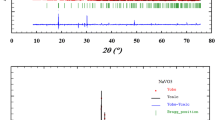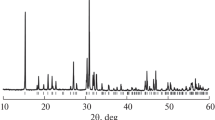Abstract
Combined with Fourier transform infrared spectroscopy (FTIR) analysis of sodium vanadate solution, the relationship between conductivity and structure was investigated by measuring the electric conductivity of the solution under different alkali concentrations and molar ratios of NaOH to V2O5. Results suggest that the polymerization vanadium acid radical ions gradually transform into monomer with the solution diluting. When the solution is diluted to a certain extent, only the vanadium acid radical ion with V–OH chemical bond exists in the solution. At NaOH concentration of below 105.21 g·L−1, the vanadate anions mainly exist in the form of vanadium acid radical ion with V–OH chemical bond and the ion transference number is approximately from 0.58 to 0.82. In the medium NaOH concentration range of 105.21–117.03 g·L−1, the vanadate anions mostly exist in the form of vanadium acid radical ion with V–OH and V–O–V chemical bonds and the ion transference number is approximately 3.29. At NaOH concentration of above 117.03 g·L−1, vanadate anions exist in the form of vanadium acid radical ion with V–OH and V–O–V chemical bonds.






Similar content being viewed by others
References
Liu LJ, Li JB, Bin ZY. Study on process technology of silica and charcoal based vanadium ore. Nonferr Metals (Mineral Processing Section). 2006;3:28.
Lu ZL. Investigation and industrial practice on extraction of V2O5 from stone coal containing vanadium by acid process. Hydrometall China. 2002;21(4):179.
Liao SM, Bo TL. Foreign Vanadium Metallurgy. Beijing: Metallurgy Industry Press; 1985. 191.
Yang JL, Jin X. A new way of recovering vanadium from iron/vanadium slag. J Beijing Univ Chem Technol. 2007;34(3):254.
Yu JG, Zhu ZZ, Yang J. Effect of microwave roasting–acid leaching on extraction of vanadium from stone coal. Hydrometall China. 2011;30(2):111.
Kang Y, Zhang XY, Tian XD, Yang YL, Chen YB. Leaching of vanadium from chromium residue. Hydrometallurgy. 2010;103(1):7.
Zhang YM, Bao SX, Liu T, Chen TJ, Huang J. The technology of extracting vanadium from stone coal in China: history, current status and future prospects. Hydrometallurgy. 2011;109(2):116.
Ye PH, Wang XW, Wang MY, Fan YY, Xiang XY. Recovery of vanadium from stone coal acid leaching solution by co-precipitation alkaline roasting and water leaching. Hydrometallurgy. 2012;117(2):108.
Zhu XB, Zhang YM, Liu T. Experiment and mechanism of vanadium extraction from stone coal by roasting with activators. Chin J Rare Metal. 2013;37(2):283.
Yan WB, Hu LS, Gao F, Hua J, He XB. Effect of manganese dioxide on acid leaching of vanadium from stone coal. Chin J Rare Metal. 2013;37(1):130.
Zhao J, Zhang YM, Huang J, Liu T, Wang F, Liu J. Process of blank roasting–sulphuric acid leaching of vanadium with leaching agent from stone coal. Chin J Rare Met. 2013;37(3):446.
Yang SZ. Extractive Metallurgy of Vanadium. Beijing: Metallurgical Industry Press; 2010. 27.
Wang DQ. Structure evolution of sodium aluminate solution during the seeded precipitation process. Changsha: Central South University; 2012. 28.
Ramesh S, Yuen TF, Shen CJ. Conductivity and FTIR studies on PEO–LiX [X: CF3SO3 −, SO4 2−] polymer electrolyte. Hydrometallurgy. 2008;69(2):670.
Jia MQ, Jang WS. Applied Electrochemistry. Beijing: Higher Education Press; 2004. 17.
Fu XC, Shen WX, Yao TY, Hou WH. Physical Chemistry, Fifth Edition, Part ii. Beijing: Higher Education Press; 2006. 9.
Hu YJ, Ouyang YJ. The comprehension of definition of ionic transference number and its formula derivation in electrochemistry. J Huaihua Univ. 2004;23(2):37.
Nie LH. Calculation of ionic transference number. Guangdong Chem Ind. 2010;37(2):75.
Yang WZ. Electrochemistry Base. Beijing: Peking University Press; 1982. 43.
Acknowledgments
This study was financially supported by the National Natural Science Foundation of China (No.51304129) and the Natural Science Foundation of Shandong Province (No.ZR2013EEM005).
Author information
Authors and Affiliations
Corresponding author
Rights and permissions
About this article
Cite this article
Zhang, YL., Yang, LQ. & Yu, XJ. Structures of sodium vanadate solution under different conditions. Rare Met. 37, 59–65 (2018). https://doi.org/10.1007/s12598-015-0525-2
Received:
Revised:
Accepted:
Published:
Issue Date:
DOI: https://doi.org/10.1007/s12598-015-0525-2




